

Handbook. Stop Relying on Training for Employee Learning. Formal training continues to take up too much of organizational resources.

Formal, event-based training (courses, workshops, seminars, MOOCs) has a place in corporate learning but only a small place and only for employee learning that can’t be achieved in other, more timely, less costly, and more effective ways. Grovo-21st-Century. My first MOOC experience (part 2) - Is this turning into a Social Media network tailored entirely around learning? It’s now week 3 in the Talk the Talk MOOC provided by Futurelearn.

I have to admit, time availability and other commitments have kept me from keeping up with the schedule of the course and I have just completed Week 2´s tasks. Week 2 has indeed proven to be a rather unique learning experience. Apart from watching videos of good practices, reading advice on how to prepare an introduction that would capture the attention of the audience; I also got the chance to video record my own introduction on my laptops webcam.
What’s more, I got feedback on my own introduction, which I must say in most cases was rather constructive. Source of image: Openclipart.org. Leading & Learning. When I went to ASCD last week, I picked up, “Evocative Coaching.”
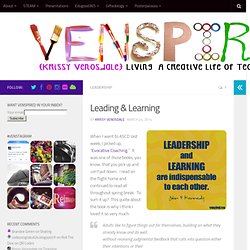
It was one of those books, you know, that you pick up and can’t put down. I read on the flight home and continued to read all throughout spring break. To sum it up? This quote about the book is why I think I loved it so very much: Adults like to figure things out for themselves, building on what they already know and do well, without receiving judgmental feedback that calls into question either their intentions or their abilities. 72278. 4 Questions That Drive Learning Results. All learning includes the asking and answering of four questions.
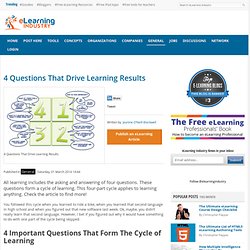
These questions form a cycle of learning. This four-part cycle applies to learning anything. Check the article to find more! You followed this cycle when you learned to ride a bike, when you learned that second language in high school and when you figured out that new software last week. Ok, maybe, you didn’t really learn that second language. What happens when we learn? Current brain research confirms that we travel a four-part cycle when we take in and make meaning of new information.
Step 1 – EngageSomething happened and your attention is gained. When any of the four steps of this process is skipped, learning suffers. This 4-step process is called 4MAT®. #SOLO Heaven. Over the past fourteen years, as a headteacher, I have led many professional development sessions for staff and introduced a number of different strategies and initiatives.
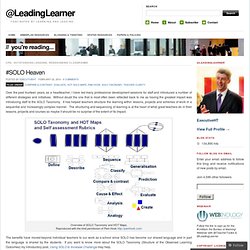
Without doubt the one that is most often been reflected back to me as having the greatest impact was introducing staff to the SOLO Taxonomy. It has helped teachers structure the learning within lessons, projects and schemes of work in a sequential and increasingly complex manner. The structuring and sequencing of learning is at the heart of what great teachers do in their lessons, projects and courses so maybe it should be no surprise of the extent of its impact. Overview of SOLO Taxonomy and HOT Maps.Reproduced with the kind permission of Pam Hook The benefits have moved beyond individual teachers to our work as a school since SOLO has become our shared language and in part the language is shared by the students. Compare & Contrast HOT Compare and Contrast Template_2010 V1 Evaluation. An Interactive Image. Google Voice Comments ~ Teaching with Technology. Founded on the belief that one-on-one mentoring sessions are really the best way to teach writing, but understanding that due to time constraints this is almost always impossible, the team at learn.ly added to the Google Docs comments functionality by allowing teachers to leave voice feedback.
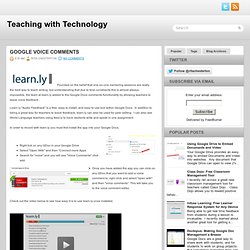
Learn.ly "Audio Feedback" is a free, easy to install, and easy to use tool within Google Docs. In addition to being a great way for teachers to leave feedback, learn.ly can also be used for peer editing. I can also see World Language teachers using feed.ly to have students write and speak in one assignment. In order to record with learn.ly you must first install the app into your Google Docs.
Right lick on any GDoc in your Google Drive Select "Open With" and then "Connect more AppsSearch for "voice" and you will see "Voice Comments" click add. Cognitive Load Theory & Instructional Design at UNSW. Research into Cognitive Load Theory and Instructional Design at UNSW Dr.
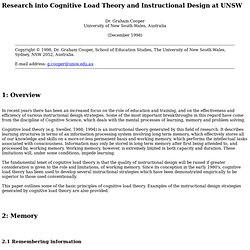
Graham CooperUniversity of New South Wales, Australia (December 1998) 1: Overview. The Maker Movement and the Rebirth of Constructionism. Educational theory and practice have begun to appear more frequently in the popular press.

Terms such as collaborative learning, project-based learning, metacognition, inquiry-based learning, and so on, might be new to some audiences, but they have a relatively long and well-documented history for many educators. The most widely-known and promising pedagogical approach is constructivism grounded on the work of Piaget, Vygotsky, and Bruner. Given how it has transformed my own understanding of pedagogy, teaching, and learning, constructionism seems ripe for a similar resurgence — like a phoenix rising from the ashes of Taylorization and standardized testing. Designing_Successful_e-Learning.pdf. Designing_Successful_e-Learning. Designing_lesson_plans_using_backward_design.